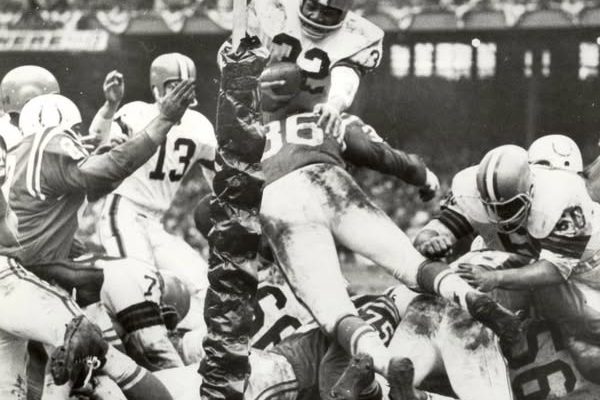On a bitterly cold December afternoon in 1964, Cleveland Municipal Stadium stood not only as a coliseum of brick and steel, but as the birthplace of one of professional football’s most unexpected and glorious triumphs. The Cleveland Browns, under head coach Blanton Collier, staged a game for the ages, routing the seemingly invincible Baltimore Colts 27–0 in the NFL Championship Game. This was no ordinary win—it was a full-fledged shockwave that reverberated across the sports world, an emphatic declaration that football’s crown could belong to the unlikeliest of champions. For the city of Cleveland, it remains the last NFL Championship—an untarnished golden memory that continues to shine even through decades of frustration, near-misses, and heartbreak.
Heading into the title game, the odds-makers, fans, and media overwhelmingly favored the Baltimore Colts. Why wouldn’t they? The Colts roster was stacked with legendary talent, most notably the iconic quarterback Johnny Unitas and his go-to receiver, Raymond Berry. Baltimore had steamrolled through the regular season and were widely considered the team of destiny. Their efficient, high-powered offense, along with a disciplined defense, made them the darlings of the league. Analysts were quick to crown them champions long before the teams took the field, with many suggesting that Cleveland would be lucky to stay within two scores of the mighty Colts. But the Browns, dismissed by nearly everyone, were quietly confident. Their head coach, Blanton Collier, a former assistant under Paul Brown, had been methodically preparing a counterstrike that would go down in football lore.
The first half of the game was a study in defensive discipline. Neither team could break through, as both defensive units imposed their will. For the Browns, it was an opportunity to showcase their unsung heroes. The defensive line pressured Unitas relentlessly, forcing hurried throws and disrupting timing routes that had worked all season for Baltimore. The secondary, led by players like Bernie Parrish and Ross Fichtner, blanketed Berry and the other Colts receivers. Despite the game being scoreless at halftime, there was a noticeable shift in momentum. Cleveland had weathered the storm. Now it was time to strike.
The floodgates opened in the second half. Quarterback Frank Ryan, a Yale-educated field general with a cannon arm and keen football IQ, took control of the offense and never looked back. He began to exploit the cracks in the Colts’ defense, and the Browns’ offense found its rhythm. Gary Collins, a lanky receiver with sure hands and deceptive speed, became the unexpected star of the day. Ryan connected with him on three touchdown passes, including a pair of beautifully arched bombs that cut through the cold December air like poetry in motion. Collins finished the game with 130 receiving yards and set a championship record with three touchdown receptions. His performance was nothing short of heroic and remains one of the greatest receiving displays in NFL postseason history.
Although Ryan and Collins stole the spotlight on the stat sheet, it was the ever-imposing presence of Jim Brown that truly set the tone for Cleveland. While he didn’t have a headline-grabbing stat line in this particular game, his impact was undeniable. Every carry felt like a sledgehammer against the Colts’ front seven. Brown’s punishing runs softened the defense, drawing in linebackers and safeties, which allowed Ryan more freedom in the passing game. His effort that day was a lesson in leadership and grit, perfectly encapsulating the unselfishness and tenacity that made him a legend. It would be Jim Brown’s final NFL game—he would retire at the peak of his powers the following year, choosing to walk away from football to pursue acting and social advocacy. That championship victory was the crowning moment of a career already steeped in greatness.
The second-half dominance turned what was expected to be a nail-biter into a rout. The final whistle blew with the scoreboard frozen at 27–0, a stunning shutout that no one had predicted. Cleveland fans erupted with joy, filling the icy air with roars of celebration. The images from that day—players hoisting the trophy, fans swarming the field, and confetti dancing in the wind—remain etched in the city’s collective memory. The game wasn’t just a win; it was a defining cultural moment for Cleveland, a city that had long battled against the shadow of sports futility.
That 1964 Browns team, in retrospect, embodied everything Cleveland would come to cherish in its sports heroes: toughness, resilience, humility, and defiance in the face of doubt. While other cities have celebrated multiple championships since then, Cleveland has clung to this game as a sacred relic. It’s not just the last time the Browns won an NFL title—it’s the last time the city stood atop the football world. Every heartbreak that followed, from The Drive to The Fumble to countless rebuilds, has only made the memory of that afternoon more precious.
Blanton Collier’s understated leadership proved to be just what the Browns needed in that magical season. Taking over for the legendary Paul Brown in 1963, Collier inherited a team with talent but also tension. He had the unique ability to connect with players and unify the locker room. His decision-making in the 1964 Championship Game—from his offensive game plan to the defensive assignments—was masterful. He didn’t need to out-yell his opponent; he simply out-coached them. His calm, calculated approach laid the foundation for one of the most lopsided and iconic championship performances in league history.
The 1964 title remains a source of pride not just for those who witnessed it, but for subsequent generations of Browns fans who’ve grown up hearing stories about that unforgettable December day. Fathers told sons. Grandparents shared tales with grandchildren. Even as Cleveland endured long playoff droughts and heartbreaking near-misses, that singular triumph stood tall, like a lighthouse guiding a loyal fanbase through stormy waters.
NFL historians often place the 1964 Browns in discussions not just for their upset, but for the sheer completeness of their win. Shutting out a team like the Colts, with their offensive firepower and Hall of Fame talent, is a feat rarely duplicated. The Browns didn’t sneak past Baltimore—they dismantled them, erasing any doubt about who deserved to hoist the trophy. That level of dominance in a championship setting is part of what makes the game legendary.
As the years have passed, the legend of that game has only grown. Vintage clips of Collins’ touchdown grabs, Jim Brown’s bulldozing runs, and Frank Ryan’s commanding presence are replayed like sacred footage every time the Browns show flashes of resurgence. Even with the emergence of newer stars and different eras, nothing has quite replicated the magic of 1964. It wasn’t just a win—it was a narrative flip, a proof that heart and strategy could overcome hype and reputation.
Today, with a new generation of Browns players chasing that elusive next championship, the ghost of 1964 lingers—haunting, inspiring, and reminding them of what’s possible. Every fan in the Dawg Pound knows the story. Every banner in the rafters traces back to that game. It’s a measuring stick, a goal, a myth, and a memory all in one. In a sport often obsessed with the present and future, the Browns’ past—especially that crisp December afternoon—remains the city’s most treasured football possession.
In the long and often turbulent saga of Cleveland sports, the 1964 NFL Championship is more than a chapter. It’s a foundation, a touchstone, and a source of eternal hope. It’s the day David beat Goliath, when a blue-collar city saw its team rise above all odds and claim football immortality. For the Cleveland Browns and their faithful fans, that win wasn’t just history—it was heritage. A moment carved into the frozen soil of Municipal Stadium and the frozen hearts of a loyal city still waiting to dream again.



